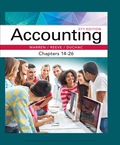
a.
Statement of
Direct method: The direct method uses the cash basis of accounting for the preparation of the statement of cash flows. It takes into account those revenues and expenses for which cash is either received or paid.
Cash flows from operating activities: Cash flows from operating activity represent the net cash flows from the general operation of the business by comparing the cash receipt and cash payments.
Cash Receipts: It encompasses all the cash receipts from sale of goods and on account receivable.
Cash Payments: It encompasses all the cash payments that are made to suppliers of goods and all expenses that are paid.
The below table shows the way of calculation of cash flows from operating activities:
| Cash flows from operating activities (Direct method) |
| Add: Cash receipts. |
| Cash receipt from customer |
| Less: Cash payments: |
| To supplier |
| For operating expenses |
| Income tax expenses |
| Net cash provided from or used by operating activities |
To Determine: The amount of cash received from customers.
b.
The amount of cash payments for income taxes.
c.
To Explain: Why the cash received from customers is different from sales.
Want to see the full answer?
Check out a sample textbook solution
Chapter 16 Solutions
Accounting, Chapters 14-26
- No Ai A company's retained earnings increase when:A. Dividends are paidB. The company incurs a net lossC. New shares are issuedD. The company earns net incomearrow_forwardA company's retained earnings increase when:A. Dividends are paidB. The company incurs a net lossC. New shares are issuedD. The company earns net incomearrow_forwardThe matching principle requires:A. Revenues to be recorded when cash is receivedB. Expenses to be recognized when incurred, matched with revenuesC. Assets to be recorded at market valueD. Liabilities to be recorded only when paid i need carrow_forward
- The financial statements of Dobson Company appear below: DOBSON COMPANY Comparative Balance Sheet December 31, Assets Cash Short-term investments Accounts receivable (net). Inventory.... Property, plant and equipment (net). Total assets Liabilities and stockholders' equity Accounts payable.. Short-term notes payable. Bonds payable. Common stock. Retained earnings. Total liabilities and stockholders' equity. Net sales Cost of goods sold Gross profit. Expenses Administrative expenses Selling expenses Interest expense... Total expenses. Income before income taxes Income tax expense. Net income... Additional information: DOBSON COMPANY Income Statement For the Year Ended December 31, 2019 2019 P 35,000 2018 P 40,000 15,000 60,000 50,000 30,000 50,000 70,000 250,000 P400,000 300,000 P500,000 P 10,000 40,000 88,000 P 30,000 90,000 160,000 160,000 145,000 102,000 75,000 P400,000 P500,000 P360,000 198,000 162,000 P59,000 40,000 12,000 111,000 51,000 15,000 P 36,000 a. Cash dividends of P9,000…arrow_forwardThe matching principle requires:A. Revenues to be recorded when cash is receivedB. Expenses to be recognized when incurred, matched with revenuesC. Assets to be recorded at market valueD. Liabilities to be recorded only when paidarrow_forwardA contra-asset account has what type of balance?A. DebitB. CreditC. ZeroD. Variableneed helparrow_forward
- Which of the following is not a current asset?A. InventoryB. Prepaid InsuranceC. Accounts PayableD. Cashneed helparrow_forwardWhich of the following is not a current asset?A. InventoryB. Prepaid InsuranceC. Accounts PayableD. Casharrow_forwardDepreciation is recorded in the books to:A. Allocate the cost of an asset over its useful lifeB. Estimate the resale value of assetsC. Track market valueD. Match expenses with liabilities need helparrow_forward
- Depreciation is recorded in the books to:A. Allocate the cost of an asset over its useful lifeB. Estimate the resale value of assetsC. Track market valueD. Match expenses with liabilitiesarrow_forwardA contra-asset account has what type of balance?A. DebitB. CreditC. ZeroD. Variablei need helparrow_forwardA contra-asset account has what type of balance?A. DebitB. CreditC. ZeroD. Variablearrow_forward
 Managerial AccountingAccountingISBN:9781337912020Author:Carl Warren, Ph.d. Cma William B. TaylerPublisher:South-Western College Pub
Managerial AccountingAccountingISBN:9781337912020Author:Carl Warren, Ph.d. Cma William B. TaylerPublisher:South-Western College Pub Financial Accounting: The Impact on Decision Make...AccountingISBN:9781305654174Author:Gary A. Porter, Curtis L. NortonPublisher:Cengage Learning
Financial Accounting: The Impact on Decision Make...AccountingISBN:9781305654174Author:Gary A. Porter, Curtis L. NortonPublisher:Cengage Learning College Accounting, Chapters 1-27AccountingISBN:9781337794756Author:HEINTZ, James A.Publisher:Cengage Learning,
College Accounting, Chapters 1-27AccountingISBN:9781337794756Author:HEINTZ, James A.Publisher:Cengage Learning, Financial AccountingAccountingISBN:9781337272124Author:Carl Warren, James M. Reeve, Jonathan DuchacPublisher:Cengage Learning
Financial AccountingAccountingISBN:9781337272124Author:Carl Warren, James M. Reeve, Jonathan DuchacPublisher:Cengage Learning Financial And Managerial AccountingAccountingISBN:9781337902663Author:WARREN, Carl S.Publisher:Cengage Learning,
Financial And Managerial AccountingAccountingISBN:9781337902663Author:WARREN, Carl S.Publisher:Cengage Learning,





